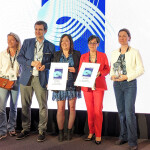The Hiranai Fisheries Cooperative Association hosted a scallop-tasting event on 10 July at the Hotel Granvia Osaka. It was attended by about 100 seafood dealers, supermarket buyers and dignitaries.
Waiting guests received informational brochures and a gift set of a new product: canned scallops in mayonnaise sauce. In opening speeches, coop leaders noted export successes in the United States, France and China.
Masaharu Uemura, Japan Fisheries Group's chairman for Aomori Prefecture, said the area's department stores now carry fresh Hiranai scallops and urged attendees to try them raw. All of the coop's exports are handled through Japanese trading companies, while the coop itself is focused on the fresh domestic market, with superior sweetness as the main selling point.
Next was a video history of scallop cultivation in Mutsu Bay. Scallops in the bay are grown on suspended nets or lines, not dredged from the seafloor as in other areas, so the harvest does not disturb the benthic ecosystem.
A wet bar and mini singing concert put guests in a receptive mood as they sampled buffet dishes. Satoshi Nakata, chief buyer for supermarket chain Konomiya, photographed and took notes on various dishes, seeking new preparation styles for the delicatessen section. Dishes served included scallop and plum Mille-feuille, scallop and salmon tartar, scallop and vegetable terrine, scallop and zucchini marinate, scallop pot pie, scallop and seafood in a mushroom fricassee, scallop and spinach gratin, breaded scallop with tartar sauce, and scallop and sablefish with ponzu sauce.
One attendee said she had thought winter was scallop season, but learned that late summer through September is best. Plentiful plankton flows into Mutsu Bay with northbound ocean currents from the Sea of Japan in spring. Feeding on the plankton, Hiranai scallops develop the highest levels of glycogen among all Japanese scallops, resulting in the sweetest taste. Growth slows in fall when plankton levels decline, and the shellfish direct their stores of energy toward forming eggs, which are released in December.
Kazuto Toyoshima, head of the Hiranai Fisheries Cooperative Association, said that in previous years the association had tried to plan joint promotions with Osaka hotels, but found that individual hotel managers and chefs could not commit to using only one brand of scallops.
"If they use many different brands, the promotion is meaningless," he said. By gaining approval of the main buyers at the chain level, they received the commitments they needed to carry out a strong joint marketing campaign in Osaka this year.
Hiranai City, located on northern Honshu Island, is Japan's top scallop port. Other leading scallop-producing prefectures are Iwate, Miyage and Hokkaido, known for the largest scallops.






